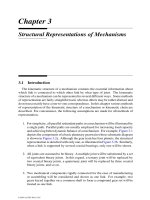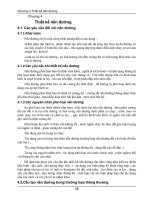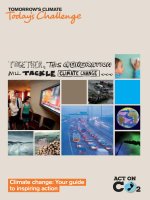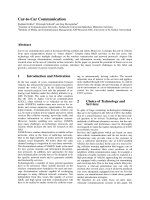PATHS TO SUSTAINABLE ENERGY_1 pptx
Bạn đang xem bản rút gọn của tài liệu. Xem và tải ngay bản đầy đủ của tài liệu tại đây (25.67 MB, 342 trang )
PATHS TO
SUSTAINABLE ENERGY
Edited by Ja n Nathwani
and Ar e W. Ng
Paths to Sustainable Energy
Edited by Jatin Nathwani and Artie W. Ng
Published by InTech
Janeza Trdine 9, 51000 Rijeka, Croatia
Copyright © 2010 InTech
All chapters are Open Access articles distributed under the Creative Commons
Non Commercial Share Alike Attribution 3.0 license, which permits to copy,
distribute, transmit, and adapt the work in any medium, so long as the original
work is properly cited. After this work has been published by InTech, authors
have the right to republish it, in whole or part, in any publication of which they
are the author, and to make other personal use of the work. Any republication,
referencing or personal use of the work must explicitly identify the original source.
Statements and opinions expressed in the chapters are these of the individual contributors
and not necessarily those of the editors or publisher. No responsibility is accepted
for the accuracy of information contained in the published articles. The publisher
assumes no responsibility for any damage or injury to persons or property arising out
of the use of any materials, instructions, methods or ideas contained in the book.
Publishing Process Manager Iva Lipovic
Technical Editor Teodora Smiljanic
Cover Designer Martina Sirotic
Image Copyright Eric Broder Van Dyke, 2010. Used under license from Shutterstock.com
First published December, 2010
Printed in India
A free online edition of this book is available at www.intechopen.com
Additional hard copies can be obtained from
Paths to Sustainable Energy, Edited by Jatin Nathwani and Artie W. Ng
p. cm. ISBN 978-953-307-401-6
free online editions of InTech
Books and Journals can be found at
www.intechopen.com
Chapter 1
Chapter 2
Chapter 3
Chapter 4
Chapter 5
Chapter 6
Chapter 7
Chapter 8
Preface IX
Public Policy and Planning
for a Sustainable Energy Future 1
Backcasting a Future of Sustainable Energy:
A Public Policy Perspective 3
Jatin Nathwani and Artie W. Ng
Sustainable Development
vs Environmental Engineering: Energy Issues 13
Artur Pawłowski
A Call to Action 29
Herschel Specter
Energy Planning: A Sustainable Approach 57
Julio Terrados, Gabino Almonacid and Jorge Aguilera
The Passive Greenhouses 75
Marius M. Balas, Calin B. Musca and Sanda V. Musca
Decision Support for National Sustainable
Energy Strategies in an Integrated
Sustainability Assessment Framework 93
Erik Laes and Aviel Verbruggen
Regional Approach for Policies and
Measures Aiming to Sustainable Energy Development 117
Valentinas Klevas
Identifying Regional Behavior Impacts
of Electricity Generation in Electricity Market
with SSNIP and Granger Test 133
Z. Tavassoli Hojati and S. F. Ghaderi
Contents
Contents
VI
Supporting Psychosocial Processes towards a Sustainable
Energy System: The Case of CO
2
Geological Storage 155
Samuela Vercelli
An Advanced Method of Congestion Management
for Optimal Energy Pricing 181
Muhammad Bachtiar Nappu and Tapan Kumar Saha
Utilization of Solar and Wind Resources
197
PV Solar Energy Conversion Using
the Behavior Matching Technique 199
Marcio Mendes Casaro and Denizar Cruz Martins
Cost Calculation Algorithm for Photovoltaic Systems 211
İrfan Güney and Nevzat Onat
Wind Energy 237
Chaouki Ghenai and Armen Sargsyan
Introduction to Doubly-Fed Induction Generator
for Wind Power Applications 259
John Fletcher and Jin Yang
The Role of Aesthetics, Visual and Physical
Integration in Building Mounted Wind Turbines
– An Alternative Approach 279
Tim Sharpe
New Systems Thinking and Policy Means
for Sustainable Energy Development 301
Niels I. Meyer
Developing Wind Energy in Turkey 315
Murat Gökçek
Energy Storage and Efficient Use of Energy 331
Understanding the Vanadium Redox Flow Batteries 333
Christian Blanc and Alfred Rufer
Desing of Multiphase Boost Converter
for Hybrid Fuel Cell/Battery Power Sources 359
Miroslav Lazić, Miloš Živanov and Boris Šašić
Non-Isolated High-Gain DC-DC Converter
Using Charge Pump and Coupling Inductor 405
Kuo-Ing Hwu and Yeu-Torng Yau
Chapter 9
Chapter 10
Part 2
Chapter 11
Chapter 12
Chapter 13
Chapter 14
Chapter 15
Chapter 16
Chapter 17
Part 3
Chapter 18
Chapter 19
Chapter 20
Contents
VII
Advanced Power Generation Technologies: Fuel Cells 421
Farshid Zabihian and Alan S. Fung
Making Fossil Fuels Sustainable 459
Carbon Capture and Storage Technology
for Sustainable Energy 461
Malti Goel
CaO-based CO
2
Capture Technology
and Its Application in Power Plants 483
Rongrong Zhai and Yongping Yang
MEA-Based CO
2
Capture Technology
and Its Application in Power Plants 499
Yongping Yang and Rongrong Zhai
High Renewable Energy Penetration
Diesel Generator Systems 511
Chemmangot V. Nayar
Facts about Producer Gas Engine 537
G. Sridhar and Ravindra Babu Yarasu
Role of Technological Innovations
and Emerging Technologies 561
Electric Power from Rice Paddy Fields 563
Kazuya Watanabe and Koichi Nishio
Switching from Renewable to Renewable –
A Case Study from Nordic Perspective 581
Alemayehu Gebremedhin
Design and Technology for Efficient Lighting 597
R. Faranda, S. Guzzetti and S. Leva
Ground Coupled Heat Pumps in Mixed Climate Areas:
Design, Characterization and Optimization 621
Álvaro Montero, Tatyana Bandos, Julio Martos, Teresa Magraner,
Nicolás Pardo and Javier Urchueguía
Development of a Boiler
for Small Straw Bales Combustion 647
Branislav Repic, Dragoljub Dakic,
Dejan Djurovic and Aleksandar Eric
Chapter 21
Part 4
Chapter 22
Chapter 23
Chapter 24
Chapter 25
Chapter 26
Part 5
Chapter 27
Chapter 28
Chapter 29
Chapter 30
Chapter 31
Pref ac e
The need for a transformation of the global energy system with a lower environmental
footprint is now widely recognized among decision makers in government, political
leadership as well as leaders of non-governmental organizations (NGOs), the corporate
business sector and the national academies. The United Nations (UN) report on “En-
ergy for a Sustainable Future” (April 2010) is but one of many that call for a drastic re-
alignment of the global energy system on a large scale as an urgent priority to enable a
sustainable future for all. The performance of the economic system in harmony with
the goals of a cleaner environment remains at the heart of the challenge framed by
the growing demand for energy services arising from a combination of demographics
and shi ing income levels in developing countries. Our reliance on existing sources of
energy and their associated detrimental impacts on the environment- whether related
to poor air or water quality or scarcity, impacts on sensitive ecosystems and forests
and land use - have been well documented and articulated over the last three decades.
What is required is a set of credible solutions for both developed and developing coun-
tries that strike a balance between economic growth and a sustainable environment.
For example, the UN report explains,
“Clean, effi cient, aff ordable and reliable energy services are indispensable for global pros-
perity. Developing countries in particular need to expand access to reliable and modern en-
ergy services if they are to reduce poverty and improve the health of their citizens, while at
the same time increasing productivity, enhancing competitiveness and promoting economic
growth. Current energy systems are inadequate to meet the needs of the world’s poor… For
instance, in the absence of reliable energy services, neither health clinics nor schools can
function properly. Access to clean water and sanitation is constrained without eff ective
pumping capacity.”
The Report of the Interacademy Council, ‘Lighting the Way to A Sustainable Energy
Future,” succinctly summarizes the challenge for the required transition as follows,
“Making the transition to a sustainable energy future is one of the central challenges hu-
mankind faces in this century. The concept of energy sustainability encompasses not only
the imperative of securing adequate energy to meet future needs, but doing so in a way
that (a) is compatible with preserving the underlying integrity of essential natural systems,
including averting dangerous climate change; (b) extends basic energy services to the more
than 2 billion people worldwide who currently lack access to modern forms of energy; and
(c) reduces the security risks and potential for geopolitical confl ict that could otherwise arise
from an escalating competition for unevenly distributed energy resources.”
X
Preface
The awareness of the urgency to reengineer the overall balance among our accustomed
economic development models, life-styles and the use of energy sources is gaining mo-
mentum. While there is interest among diverse stakeholders in formulating solutions
for energy sustainability, there is a need to focus the collective wisdom to formulate
eff ective solutions. We believe this book provides an open platform to establish and
share such intellectual capital among scholars, scientists and engineers from all over
the world about various viable paths to a future of sustainable energy.
We hope that this book will provide a bridge for stakeholders with practical guidance
to pursue the paths to a sustainable energy future. Success will depend on continuous
technological innovation, cross-border knowledge sharing and technology transfer,
timely local deployments and implementations. Moreover, the world needs a parallel
development of frameworks and policies to reinforce and build on the successes one
step at a time over the coming decades. This book is organized into the following fi ve
sections:
I. Public policy and planning for a sustainable energy future
II. Utilization of solar and wind resources
III. Energy storage and effi cient use of energy
IV. Making fossil fuels sustainable
V. Role of technological innovations and emerging technologies.
Starting with the exploration of the imperatives of public policy and planning for sus-
tainable energy in Section I, scholars from various countries examine the critical issues
to be addressed in formulating sustainable energy policies and planning for the future
within the electricity sector. Section II collects articles about the increasingly popular
utilization of the natural resources that do not generate emissions in their power gen-
erating processes, namely solar and wind, to generate electricity. The subsequent Sec-
tion III and IV provide a platform to share knowledge about the growing interests and
uses of energy storage technologies, such as fuel cells, as well as the possible solutions
to mitigate the problems with GHG emissions caused by fossil fuels. Section V is a
collection of articles that explore other technological innovations and implications for
enhancing the development of sustainable energy systems.
Jatin Nathwani
Professor and Ontario Research Chair in Public Policy for Sustainable Energy
Executive Director, Waterloo Institute for Sustainable Energy
University of Waterloo, Ontario, Canada
Artie W. Ng
Fellow, Public Policy Research Institute
Senior Lecturer, School of Professional Education & Executive Development
The Hong Kong Polytechnic University
Part 1
Public Policy and Planning
for a Sustainable Energy Future
1
Backcasting a Future of Sustainable Energy:
A Public Policy Perspective
Jatin Nathwani
1
and Artie W. Ng
2
1
Waterloo Institute for Sustainable Energy, University of Waterloo
2
Public Policy Research Institute / School of Professional Education & Executive
Development, The Hong Kong Polytechnic University
1
Canada
2
Hong Kong
1. Introduction
Although the adoption of renewable energy is perceived as a means to enable delivery of
emission-free solutions, its penetration into the energy market has not been timely and
significant enough to make a material impact on the structure of the global energy system.
Using backcasting as a policy tool for developing a view of a sustainable energy future, this
Chapter aims to explore some of the critical hurdles as the policy makers continue to
formulate and advance environmentally friendly energy consumption in order to mitigate
the impacts of climate change. We illustrate the nature of the challenges to reach a wider
adoption of alternative energy resources and build on the need for renewal of the energy
“delivery” infrastructure through the “smart grid” as a means for transition to a sustainable
economy in the longer term.
While there is now engagement with the public about a sustainable future, alignment of
stakeholders’ economic interests and absorption capacity of emerging technologies remain
as the two main challenges in mitigating the underlying systemic hurdles to be overcome.
As the public at large realize the need for a future of sustainable energy despite lack of a
global consensus about definitive targets, the policy makers may seek to provide a
combination of approaches that build on optimal investment incentives in the near-term,
liberalization of the electricity grids in the medium term and a dynamic policy framework
that induce continuous technological innovation in the longer term. Observing the current
responses to the externalities by the policymakers in a number of jurisdictions we articulate
such forthcoming initiatives to mitigate the systemic hurdles embedded in the existing
energy infrastructure. We also articulate measures to enable deployment of integrative
sustainable energy solutions over a transformed infrastructure, namely smart grid.
2. Backcasting a future of sustainable energy
Prior and current studies of energy use have confirmed the problems with the deterioration
of air quality and the consequences of lingering reliance of fossil fuels in the modern global
economy. The public concern about sustainability of the environment and the ongoing
Paths to Sustainable Energy
4
issues with climate change remains an important driver of social and political influence.
Advocates, mainly from the developed economies have argued for a set clear objectives and
targets on emission of Greenhouse Gases (GHG). There is, however, no unanimity and
divergent perspectives emerge as at the core of the debates across the globe. Individual
countries at different stages of economic development have advocated to jointly limiting
their emission to a certain level in response to the adverse effects resulting from climate
change. Such an initiative resembles the concept of backcasting for an end point in time with
a pre-determined target (Robinson 1982; Ng 2009). Under such an initiative, a future of
sustainable energy with a cap on GHG emission is desired as target.
Such multilateral negotiations have proved to be highly challenging given the complexity of
politics involved with respective jurisdictions and the diversity of stakeholders’ interests.
This was demonstrated in the UN Climate Summit held in Copenhagen December 2009
where multilateral agreements over specific target or cap were attempted but failed
inevitably.
1
3. Challenges at the policy level
3.1 Rethinking the targets and constraints in backcasting
Although the stakeholders tend to concur on the broad need to deal with issues of climate
change and the desire to improve sustainability, there is no coherent plan or a clear road
map to a sustainable future. Some argue that there is not sufficient political will among the
major players to drive the conclusion of a target at a future point in time (BBC 2009). There
are concerns that the un-reconciled targets among the nations would hamper any further
progression towards a sustainable future.
In the backcasting methodology, however, it is suggested that while it is critical to have a
certain degree of consensus among the key public stakeholders, such a consensus for
practical purposes is only around qualitative values. (Robinson 2003). Further development
of specific targets would take place at another level on which the local stakeholders might
seek more precise sub-optimal targets. In reality, this would be an iterative process with end
points and scenarios guiding the process of planning towards the future prior to specific
quantifications (Ng 2009).
As reflected in the current public policy formulations among various jurisdictions, the
momentum to improve sustainability is still observable despite their respective variations in
pace and strategy. Allegedly there are differences in constraints among the political systems
as well as in embedded objectives. While some jurisdictions might be accustomed to more
explicit and definitive commitments, some might have practical concerns over commitments
that could be disagreeable by domestic stakeholders. For instance, the European Renewable
Energy Council (EREC) has developed a detailed roadmap and specific renewable energy
consumption target of 20% by 2020 (Zervos and Lins 2010); such a target could be exceeded
by another 20% with reference to the assumption that EU might have even implemented a
more ambitious roadmap. Other advanced economies, such as U.S. and Canada however
have not developed a national target despite commitment devised by certain states and
1 BBC (2009) reported on the various reasons for the failure of to reach an agreement with quantifiable
measures and noted, “The logical conclusion is that this is the arrangement that the big players now
prefer - an informal setting, where each country says what it is prepared to do - where nothing is
negotiated and nothing is legally binding.”
Backcasting a Future of Sustainable Energy: A Public Policy Perspective
5
provinces. China, another major player in the global economy, has voluntarily to set a target
of 15% by 2020. The variations in commitment among these major economies is evidence of
the differences in pace of economic growth, existing energy portfolio mix and the level of
advancement and implementation of renewable energy technologies in the supply mix.
Fig. 1. Backcasting framework for the renewable energy sector (Ng 2009)
3.2 Optimization under moving targets
Although there are no confirmed targets set through multilateral agreements, this has not
dampened the furthering of policy initiatives to improve the sustainability of energy supply.
It is understandable that politicians have difficulties in committing to targets that have short
term ramifications on energy supply security, prices and affordability and reliability. Under
the preferred voluntary approach, individual countries influenced by both international and
domestic political pressures continue to admit their concerns about over reliance on fossil
fuels. The public at large has increasingly acknowledged the cost of such externalities to the
environment and to the health impacts, which are seen as the common values and
constraints agreeable among the human beings. While more resources are being allocated to
develop and build capacity of renewable energy, the approach and roadmap to a scenario of
Paths to Sustainable Energy
6
sustainable energy would still be subject to subsequent transformation of the energy
infrastructure as well as technological advancement for renewable energy resources. In
other words, the jurisdictions would continue to seek their individual plausible stepping
stone through optimization (Ng and Nathwani 2010).
Fig. 2. Dynamic policy development towards a future sustainable energy (Ng and Nathwani
2010)
4. Emerging country policies to embrace sustainable energy
4.1 Inducing multiple sources of renewable and sustainable energy
As we move into a future of sustainable energy, the dominance of fossil fuels would have to
be replaced by a more balanced mix of energy options as suggested by Fanchi (2004).
Among the mix, the most convincing sources would seemingly be composed of hydro, solar,
wind, geothermal and wave, depending on the geographical dimensions. In order to ensure
stability of electricity loading and energy supply, the use of nuclear energy is likely to be
maintained and even increased for its complementary characteristics and carbon-free in
emission.
2
Fossil fuels, including natural gas, would still be a likely source for vehicles until
a more extensive application of electric and hydrogen-fueled vehicles.
In recent years, policy makers have attempted a number of approaches ranging from
command and control through regulations to incentives such as Feed-in Tariffs (FITs) to
2
See Nathwani et al, (1992) and more recently Mackay (2009) in his exploration of a balance sheet of
energy production and energy consumption.
Embedded Technological Infrastructure
(Social Technical Regime)
Incentives to
allocate resources
Incentives for
technological
innovation
Education and
engagement about
sustainable
development
Alignment of
stakeholders’
economic interests
Absorption capacity
for technological
solutions
Reducing
economic
risk
adversity
Policy for
Tackli n g
Systemic
Hurdles
Backcasting a Future of Sustainable Energy: A Public Policy Perspective
7
Renewable Portfolio Standards (RPS) to promote the development of renewable energy
sources through private investments. Stability of a policy framework and the supporting
governance models are considered critical to inducing new investments for renewable
energy and they will vary from context to context in different countries and political
systems. For instance, clean tech ventures are viewed as the next major investment focus
among the venture capitalists in the U.S. as the pertinent policy unveiled (Pernick and
Wilder 2010). In Canada, the study by Holburn et al. (2010) revealed the influence of
pertinent policies to induce initial investments in wind power. On the other hand, emerging
ventures have not only expanded in the domestic market but could swiftly tackle
international markets where accommodating renewable energy policies are in place as
demonstrated in the emerging renewable energy sector in Germany (Jacobsson. and Lauber
2006).
4.2 Three stages of development
For further development of renewable energy sources, a stable policy framework is
necessary and complementary for the growth and development of an industry that can be
stimulated by positive economic incentives. For example, Germany introduced FITs to
stimulate the direct investments of solar energy and wind power converted into electricity
sold through grids to the end customers giving a boost to early stage development. Such
measure enables the nurturing and development of new ventures in renewable energy as
well as the growth of pertinent knowledge and technology. The perceived investment risk
and cost of capital for such early-stage development by a firm would be reduced as a
consequence.
In the next stage of development – the medium term, the policy makers would see the need
for the development of an infrastructure that intelligently enhances the supply of renewable
energy. For instance, one of the key problems of GHG relating to emissions from fossil-
fueled vehicles would be mitigated through an extensive adoption of electric vehicles. In
particular, the development of a smart grid
3
would enhance the development and growth of
alternative energy sources while providing sufficient electricity supply to extend the use of
electric vehicles. The end users will be empowered to choose their choice of energy through
an intelligent platform for demand and supply.
In the third stage of development, sustainable and yet competitive industry, emergence of a
sustainable and yet would encourage business competitions through a smart grid that is
widely open to multiple sources of renewable energy producers as suppliers of energy to
the grid. This smart grid system would facilitate the development of a technological regime
under which technological innovation will be promoted and efficiency of renewable energy
will be further enhanced under an economic model near pure competition (World Economic
Forum 2009). For instance, solar energy ventures need continuous technological innovation
so as to make solar energy as a viable solution under the current technological regime of the
electricity market. In the next decade, the cost of solar panels could be drastically reduced
within the next generation of solar energy through technological advancement in efficiency
and mass production (Dhere 2007; Pernick and Wilder 2010).
Nonetheless, the combination of other emerging renewable energy sources as well as
development of complementary policy and technological infrastructure could perplex the
3 See Report of the Ontario Smart Grid Forum ‘Enabling Tomorrow’s Electricity System,’ IESO (2009).
Paths to Sustainable Energy
8
landscape (Johnston et. al., 2005; Johnson and Suskewicz, 2009; Ng and Nathwani, 2010).
Reaching this stage of relative market liberalization, an open market for competition
through smart grids would, for instance, promote swift development and applications of
more efficient solar panels into the electricity markets.
Fig. 4. A scenario of smart grid system in the future
4
5. Approaching the medium term – the arrival of smart grid
5.1 The significance of smart grid
As the smart grid technology becomes feasible, the policy makers become increasingly
convinced for its complementarity to sustainable energy. Smart grid could help create a
landscape for rapid technological innovation envisaged by Grin (2008). The development
experience of 3G networks in the telecom sector and the innovation of smart phones would
resemble the potentials of smart grid. Effectively, smart grid would enable consumer
empowerment and incentives through real-time information, time-based pricing and utility-
based demand controls. It would also facilitate net metering for consumer-based renewable
energy generation through solar and wind, etc. Smart grid in short represents an opportunity
to transform the existing infrastructure into one that delivers improved efficiency and optimal
capacity utilization as the consumers would ultimately be empowered to choose the most
competitive and yet sustainable sources through their smart grid. Remote sources of
renewable energy despite issues with their loading stability, including solar and wind, would
be extracted and integrated into smart grid so as to maximize their potentials to maximize
their potential under a balanced mix of sustainable energy sources.
5.2 The frontiers from the east and west
While Fanchi (2004) expressed the potential variations in energy sector development among
the various civilizations of the world, differences in the renewable energy development
4
Source: European Technology Platform SmartGrids
Backcasting a Future of Sustainable Energy: A Public Policy Perspective
9
models among countries in the east and west could be assumed. Although it is observed
that there are frontiers in the east and west which have commenced their races towards
sustainable energy through smart grid developments, there may well be variations in
approach, namely between the centralized planning in China and the market-driven ones in
the United States. The key initiatives among the frontiers in smart grid from the east and
west are summarized in Table 1.
Fig. 4. A schematic of smart grid utilization
5
East Asia Europe North America
China
• Set forth a $586 billion stimulus
plan to invest in water systems,
rural infrastructures and power
grids, including a smart grid
system.
• Prepared to invest $7.3 billion
this coming year in smart grid
technology, edging out the $7.2
billion in U.S. investments
• Aim to reduce its overall
energy consumption and make
the power distribution network
more efficient. As part of the
efforts to reduce energy
France
• Plan to use smart grid to
stabilize and to
efficiently unify
dispersed energy
supply as 78% of power
produced is from
nuclear power whereas
coal, natural gas, bio-
meth and wind power
are all various methods
used to produce power.
• Suggested integrating
renewable energy and
supplying smart meters
Canada
• National smart grid
implementation will
depend on each
province since the
electricity system is
under provincial
jurisdiction.
• Ontario declared
“Green Energy Act as a
comprehensive
government policy
action. Ontario Energy
Board in Canada
mandated a large scale
5
Source: Electric Power Research Institute
Paths to Sustainable Energy
10
consumption, smart grid
systems are being considered.
Korea
• Made a tentative deal with
Illinois to jointly develop and
test technologies for smart grid.
The two parties will set up a
pilot program to create smart
grid technology at a facility on
Jeju Island. Under the plan,
technologies that are
developed through this
partnership and are deemed
viable for commercialization
will be rolled out both in
Illinois as well as in Korean
cities. The Korea Electro-
technology Research Institute
and other related local centers
will collaborate with Illinois'
Argonne National Laboratory.
• The Korean government seeks
to complete the installment of
smart grid in the country by
2030 and establish another
27,000 or more power charge
stations for electric cars. A total
of 27.5 trillion won will be
injected according to the
roadmap. The government
plans to handle it by
developing core technology,
new markets, new
infrastructure and attracting
voluntary investment from
businesses.
Japan
• Announced a national Smart
Metering initiative and large
utilities companies announced
Smart Grid programs to
commence in 2010.
• A consortium of well known
Japanese companies, formed by
Hitachi, Toshiba, Fuji, and
Panasonic, plans to construct a
working Smart Grid system in
New Mexico by 2010. The
effort is led by Japan’s public
research and development
organization for environmental
to reflect consumer’s
demands
• France’ energy
environment public
corporation ADME
(Agence de
l'Environnement et de la
Maîtrise de l'Energie)
supports electric vehicle
technology-related
research and formulated
a smart grid roadmap.
• Planning to substitute
old fashioned electricity
meters by smart meters
by 2015 in all
households.
UK
• The British Department
of Energy and Climate
Change (DECC) and the
regulator Ofgem
published a smart grid
route map. A U.K. smart
grid could be delivered
to contribute to the
realization of
government carbon
targets and end-
customer benefits.
• The route map was
developed by the
Electricity Networks
Strategy Group (ENSG)
aiming to realize the
U.K.’s smart grid vision.
• Focus on critical smart
grid roles for the
nation’s planned low
carbon transition up to
2050, including the
integration of inflexible
generation, the
electrification of
transport and heating,
as well as integration of
distributed energy
resources.
• Three high level
objectives include
carbon reduction,
smart grid initiative by
upgrading from
traditional Automatic
Meter Reading (AMR)
to Advanced Metering
Infrastructure (AMI), a
system capable of
measuring and
analyzing energy
usage using two-way
communication,
throughout the
province. The province
plans to implement
smart meters in all
household by 2010.
• Issues of
standardization,
security, maintenance
and regulation remain
a concern while
continuing talks
between President
Obama and Prime
Minster Harper
implicate a definite
movement towards
smart grid.
U.S.
• Development of smart
grid in the United
States is stimulated by
the $4.5B USD
allocated to grid
modernization under
the American Recovery
and Reinvestment Act
(ARRA).
• Research in promising
technologies for smart
grid implementation
under the Smart Grid
Demonstration
Program (SGDP),
which allocated $100M
USD to regional smart
grid demonstrations
and $515M USD to
energy storage
demonstrations. The
Smart Grid Investment
Backcasting a Future of Sustainable Energy: A Public Policy Perspective
11
technologies, NEDO (New
Energy and Industrial
Technology Development
Organization). The Japanese
government is expected to co-
invest between $20.3 and $30.4
million in the project composed
of digital monitoring and
distribution of power as well as
solar power generation and
storage. The consortium will
retain ownership of the grid
and control it in large part via
the Internet.
energy security, and
economic
competitiveness and
affordability in
delivering a cost
effective low carbon
transition.
Grant (SGIG)
programs also allotted
$3.3B USD towards the
quick integration of
proven technologies
into existing electric
grid infrastructure.
• Renewable Portfolio
Standards (RPS) for
production of energy
from renewable
sources adopted under
state legislation.
Table 1. Key policy initiatives for smart grid development in the world
6
6. Concluding remarks: towards a scenario of market forces for sustainable
energy
As we look backward from a future scenario of multiple sources of sustainable energy, the
world today is posed to upgrade its existing energy infrastructure that would intelligently
enable us to embed sustainable policy that benefits the coming generations of the human
race. To achieve that scenario, we need to continue to develop policy that enables the
electricity and energy industries to undergo a mission-critical transformation. In particular,
finances and investments should be stimulated for resources allocation into the
development and upgrade of the existing infrastructure at a level of risk that is
commensurate with the benefits derived from a safe and secure network that provides
delivery at a high level of reliability. At the same time, there ought to be well-planned
reform of the existing electricity sector in order to facilitate a comprehensive utilization of
the smart grid system. In particular, ownership structure of the pertinent assets should
promote sufficient fair competition driving the development of a wide landscape of
technological innovation for renewable energy as envisaged by Grin (2008).
New industries for renewable energy and pertinent infrastructure are expected to be built in
the coming decades. A strong and stable policy framework plus confidence in the
governance of the energy sector will enhance the corresponding value chains development
as well as complementary ventures invested and nurtured as a consequence. Given the scale
of developments, there will essentially be cross-border collaborations to optimize the
strengths of different jurisdictions in building up the value chains for the emerging
industries of solar panels, wind turbines and other supplies for building smart grid
infrastructures. Nevertheless, the world now needs to learn about these emerging
technologies and the knowledge to deploy these intangibles continuously in an innovative
manner in order to reach a future of sustainable energy. The positive dynamics among the
policy makers, the industry innovators and the general public would need to be engendered
swiftly prior to an end point in backcasting.
6
The table is a summary of the recent studies by Korean Smart Grid Institute (2010).
Paths to Sustainable Energy
12
7. References
BBC (2009) Why did Copenhagen fail to deliver a climate deal? 22 December 2009,
( [accessed 19 August,
2010]
Dhere, N.G. (2007) Toward GW/year of CIGS production within the next decade, Solar
Energy Materials and Solar Cells, Vol. 91 No.15-16, pp. 1376-1382.
Fanchi, J. R. (2004) Energy: Technology and Directions for the Future. Elsevier Academic Press,
London, UK.
Grin, J. (2008) The multilevel perspective and design of system innovations, In: Managing the
Transition to Renewable Energy: Theory and Practice from Local, Regional and Macro
Perspectives, Edward Elgar, U.K.
Holburn, G., Lui, K. and Mor, C. (2010) Policy Risk and Private Investment in Wind Power:
Survey Evidence from Ontario, Canadian Public Policy, forthcoming.
IESO, Independent Electricity System Operator, Ontario, Canada
[accessed August 31, 2010]
Jacobsson, S. and Lauber, V. (2006) The politics and policy of energy system transformation
– explaining the German diffusion of renewable energy technology, Energy Policy,
Vol.34, No.3, pp.256-276.
Johnson, M.A. and Suskewicz, J. (2009) How to jump start the clean-tech economy, Harvard
Business Review OnPoint, Spring, pp.88-96.
Johnston, B., Mayo, M.C. and Khare, A. (2005) Hydrogen: the energy source for the 21st
century, Technovation, Vol.25, pp.569-585.
Korean Smart Grid Institute: [accessed 18 August, 2010]
Mackay, David, J.P, “Sustainable Energy – Without the Hot Air,” (2009), UIT, Cambridge,
England.
Nathwani, J.S, E. Siddall, N.C. Lind (1992) Energy for 300 Years: Benefits and Risks, Institute
for Risk Research, University of Waterloo, Waterloo, ON, Canada.
Ng, A. W. (2009) Backcasting performance of the emerging renewable energy sector in
China: A strategic optimization approach for policy making, Journal of Technology
Management in China, Vol.4, No.1, pp. 53-66(14).
Ng, A.W. and Nathwani, J. (2010) Sustainable energy policy for Asia: mitigating systemic
hurdles in a highly dense city, Renewable and Sustainable Energy Reviews, Vol.14
No.3, pp.1118-1123.
Pernick, R. and Wilder, C. (2010) Clean Energy Trends 2010, The Clean-tech Market
Authority.
Robinson, J. (1982), Energy backcasting: a proposed method of policy analysis”, Energy
Policy, December, pp. 337-44.
Robinson, J. (2003), “Future subjunctive: backcasting as social learning”, Futures, Vol. 35, pp.
839-56.
World Economic Forum (2009) Accelerating Smart Grid Investments.
Zervos, A. and Lind, C. (2010) Integration of Renewable Energy Sources, In: Renewable
Energy in Europe: Markers, Trends and Technologies, Earthscan, London.
2
Sustainable Development vs Environmental
Engineering: Energy Issues
Artur Pawłowski
Lublin University of Technology, Nadbystrzycka 40B, 20-618 Lublin
Poland
1. Introduction
Man can't live without environment, one with some strictly specified parameters. Despite
this known truth, the relation between man and environment is far from peaceful co-
existence. From history's point of view, it can be noticed that mankind have repeatedly
caused environmental disasters. At first those were purely local. The primitive nomad
usually moved elsewhere in the face of an ecological problem. Later on, the situation
became much more complicated. Underestimating the environmental conditions lead to the
downfall of the first literate and highly advanced civilization in history, the Sumerians
(Ponting, 1993), stabilized as early as 3000 B.C. The area it occupied, between the rivers of
Euphrates and Tigris (Lower Mesopotamia), favored agricultural development. The yields
were high due to the highly developed irrigating system. A rapid increase in population
was observed, along with the increasing demand for food. The increase in yields slowed
down however, and depleted systematically, reaching one-third of the maximal yields about
1800 B.C. The signs of crisis were ignored, however, which led to a complete breakdown of
the agriculture as well as the entire civilization. Among many causes of the yields' decrease,
two deserve a special mention.
• Widespread irrigation favored the increase of soil's salinity (one of the major causes of
soil degradation).
• The growing demand for food, along with the increasing populace entailed expanding
cultivated area. After utilizing all available farming areas, forests were cut out and the
land obtained in this way was cultivated. This resulted in increasing erosion – another
important form of soil degradation. Moreover, depletion of plant cover and erosion
made way to creating large runoffs and the silting of rivers, which caused floods as a
consequence.
Modern technical powers of mankind are much bigger however, than those of the
Sumerians. Our pressure on the environment has also increased. Not only can mankind
cause its own extinction, but the destruction of the entire biosphere.
Not so long ago it seemed that environmental protection will bring rescue. A breakthrough
moment of its development was the U'Thant report in 1969. Although earlier efforts to help
the environment were made – the first known act regarding the environment was
introduced in China about 1122 B.C. – it was the 20
th
century and U'Thant's report that made
way to large-scale international initiatives. Media publicity, that accompanied the report
also helped shape the worldwide society's awareness of the environmental threats.









